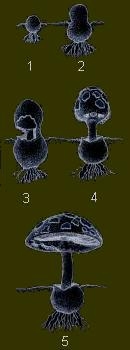Fungi Classification - What Are Fungi
 Fungi are neither plant nor animal, but have some characteristics of each. They cannot move about like an animal, do consume organic matter, have no chlorophyll as do plants, and cannot manufacture their own energy. They have a true nucleus in their cells and are able to sexually reproduce by combining like strains of nucleus. They can also reproduce by spores similar to some of the more primitive plants e.g. Ferns, Liverworts and Mosses. Modern molecular studies have shown that fungi are more closely related to animals than to plants.
Fungi are neither plant nor animal, but have some characteristics of each. They cannot move about like an animal, do consume organic matter, have no chlorophyll as do plants, and cannot manufacture their own energy. They have a true nucleus in their cells and are able to sexually reproduce by combining like strains of nucleus. They can also reproduce by spores similar to some of the more primitive plants e.g. Ferns, Liverworts and Mosses. Modern molecular studies have shown that fungi are more closely related to animals than to plants. The structures of fungi are microscopic and not visible to the naked eye. Some are unicellular like yeast, but most string their cells together in long, thread-like strands called hypha. Most fungi produce an extensive system of hyphae, which may be visible when growing thickly in a mass called mycelium (commonly referred to as mould). Mycelium can be of any size from tiny clusters to massive acre wide systems, which effectively form the feeding and growing body of the fungus.
The structures of fungi are microscopic and not visible to the naked eye. Some are unicellular like yeast, but most string their cells together in long, thread-like strands called hypha. Most fungi produce an extensive system of hyphae, which may be visible when growing thickly in a mass called mycelium (commonly referred to as mould). Mycelium can be of any size from tiny clusters to massive acre wide systems, which effectively form the feeding and growing body of the fungus. Fungi, as do other simple plants such as mosses and ferns, reproduce primarily by single celled spores. The lower fungi, or micro fungi, form asexual spore dust on their surface where it grows simply by budding off from hyphal tips and does not produce any visible structures. The vast majority of fungi are of this type.
Fungi, as do other simple plants such as mosses and ferns, reproduce primarily by single celled spores. The lower fungi, or micro fungi, form asexual spore dust on their surface where it grows simply by budding off from hyphal tips and does not produce any visible structures. The vast majority of fungi are of this type.|
|